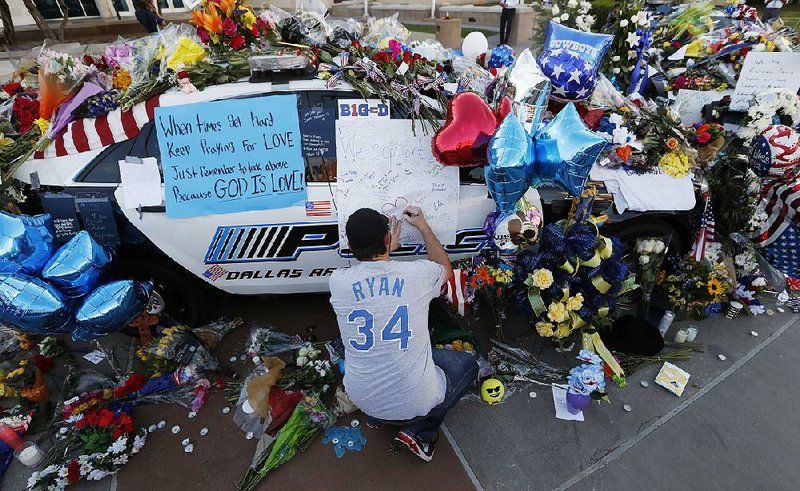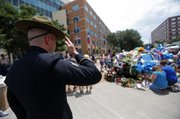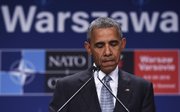WARSAW, Poland -- President Barack Obama on Saturday rejected any notion that the past week's gun violence in the U.S. signals a return to a racially dark past, saying that as painful as the killings of police and two black men were, "America is not as divided as some have suggested."
RELATED ARTICLES
http://www.arkansas…">Woman grieves shootings' toll http://www.arkansas…">Attorney: Gun, not race, prompted officer's shots http://www.arkansas…">Groups training citizens to film encounters with police http://www.arkansas…">After killings, black gun owners question treatment http://www.arkansas…">Gun-rights activist: 'Suspect' label by police defamed him
With five Dallas police officers dead at the hands of a gunman and two black men dead at the hands of police, Obama appealed to Americans not to be overwhelmed by fear of a return to 1960s-style chaos, and to understand the progress that has been made in racial relations since that time.
"You're not seeing riots, and you're not seeing police going after people who are protesting peacefully," he said. "You've seen almost uniformly peaceful protests and you've seen, uniformly, police handling those protests with professionalism."
Obama spoke at the conclusion of a NATO summit in Warsaw before leaving for Spain, part of a farewell trip to Europe that he decided to cut short by one day because of the developments back home.
His comments marked the third time in as many days that he has spoken, from a distance, about the police-involved fatal shootings of black men in Louisiana and Minnesota, and a black gunman's attack in Dallas that killed the five police officers and injured seven other officers and two civilians.
But Obama, who has angered political opponents by calling for tighter gun-control laws after deadly mass shootings during his time as president, made clear that he will continue to speak out about the need for those measures. The Republican-controlled Congress has refused to go along with them.
Obama said the U.S. is unique among advanced countries in the scale of violence it experiences.
He spoke sympathetically of police officers in gun-filled communities who have "very little margin of error" when deciding how to engage with people on the street who may or may not be armed. "Police have a really difficult time in communities where they know guns are everywhere," he said.
"If you care about the safety of our police officers, then you can't set aside the gun issue and pretend it's irrelevant."
He mentioned that laws in Texas allow the carrying of guns and that even some of the protesters in Thursday night's rally in Dallas were armed. Obama also cited the presence of an apparently legally owned gun in the car where motorist Philando Castile was shot during a traffic stop in suburban St. Paul, Minn.
Obama said the Dallas shooter, a black Army veteran who was later killed by police, was a "demented individual" who does not represent black Americans any more than a white man accused of killing blacks at a church in Charleston, S.C., represents whites.
The president said he would visit Dallas this week to pay his respects and mourn with the city. The shootings, and the ensuing protests in some U.S. cities, led Obama to cut his five-day, two-country European trip to four days. On his flight to Spain, he called Texas Gov. Greg Abbott to offer his condolences on behalf of the American people, the White House said.
In his news conference before leaving Poland, Obama said that while "there is sorrow, there is anger, there is confusion" in the U.S., "there's unity in recognizing that this is not how we want our communities to operate. This is not who we want to be as Americans, and that serves as the basis for us being able to move forward in a constructive and positive way."
The president said he planned to convene a White House meeting in coming days with police officers, community and civil-rights activists, and others to talk about next steps. He said the "empathy and understanding" that Americans have shown in responding to the events of the past few days, including Dallas police officers even as they were under attack, had given him hope.
"That's the spirit that we all need to embrace," Obama said. "That's the spirit that I want to build on."
Lives of the slain
On Saturday afternoon, the Dallas Police Department stepped up security after receiving an anonymous threat against police officers across the city, said Monica Cordova, a police spokesman.
A few officers with tactical gear were stationed about a block from the police station, and there appeared to be SWAT officers and a SWAT vehicle next-door.
Dallas was otherwise quiet Saturday as investigators continued to research the sniper's background and pore over the downtown crime scene created by Thursday's sniper attack.
In that stretch of downtown, signs of violence still littered the streets. Police officers monitoring the perimeter of the crime scene mixed Saturday with reporters and people walking their dogs in Belo Garden Park. Shattered glass remained on the ground along Elm Street. A handful of FBI investigators, wearing gloves and blue booties, were at the scene.
A makeshift memorial of flowers sat at the base of three flagpoles not far from where the shooting began. Someone had tied a red T-shirt around one of the poles with the words, "Police Lives Matter."
Flowers, balloons and ribbons covered a Dallas police cruiser and a Dallas Area Rapid Transit car. Hundreds of people had left handwritten notes on cards stamped with the phrase, "We unite." "Prayers for you and for all law enforcement," a woman named Rita had written. "We will forever be grateful for all y'all do," a man named Jeremiah had written.
A woman knelt nearby, her eyes shut tight, praying. A mile south at the Dallas police headquarters, another memorial to the five fallen officers continued to grow.
Also Saturday, more details emerged about the lives of the five slain officers.
Dallas Area Rapid Transit officer Brent Thompson, 43, had worked at the department since 2009 and was a newlywed. He was the department's first officer to be killed in the line of duty.
A colleague remembered him as quiet, determined and working to transfer to the department's motorcycle division.
Among those paying tribute to him Saturday was 10-year-old Victor Becerra, who met Thompson in the hospital after Victor had emergency appendicitis surgery. Thompson stopped by his hospital room to say hello and make him laugh.
When Victor spotted two soldiers standing at attention Saturday at a memorial for the officers, he joined them and saluted, too.
The four Dallas police officers killed included Patrick Zamarripa, a 32-year-old father and Navy veteran who enlisted in the military as a teenager just before the Sept. 11, 2001, terrorist attacks.
Zamarripa survived three tours of duty in Iraq, where he worked as a military policeman, and saw the downtown Dallas police beat as good training for future assignments, according to his father, Rick, who drove to police headquarters Saturday to see the memorial and to see where his son died.
Policing "was always his passion," Rick Zamarripa said.
The other victims were Senior Cpl. Lorne Ahrens, 48, a former semi-professional football player who had been with the department 14 years; officer Michael Krol, 40, who joined the department in 2008; and Sgt. Michael J. Smith, 55, a father of two who liked to give department stickers to children at his church.
Some of the seven injured officers were still hospitalized Saturday.
Transit officers Omar Cannon, 44, and Misty McBride, 32, were "doing well," said fellow officer Terry Mack.
'Shoot and move'
Details about the Dallas shooting and the gunman were still coming into focus Saturday.
Authorities said Army veteran Micah Johnson, 25, acted alone.
Babu Omowale, a co-founder of the city's People's New Black Panther Party, said Saturday that Johnson had attended black nationalist events in the Dallas area for a few years, but he was never a formal member or particularly active.
"I've seen his face at local events and social gatherings that we have here in the city, but we've never actually spoken to each other," Omowale said.
David Brown, the Dallas police chief, has said that during Johnson's standoff with police, he said he had set out to kill officers, particularly white ones.
Johnson had studied the "shoot-and-move" combat tactic that he used in the attack, writing about it extensively in a journal that detectives are now scrutinizing, a senior local official said Saturday.
Investigators found the "fairly voluminous" journal in Johnson's home, said Clay Jenkins, Dallas County's chief executive.
The journal described "what we call 'shoot and move' tactics -- ways to fire on a target and then move quickly and get into position at another location to inflict more damage on targets without them being able to ascertain where the shots are coming from," Jenkins said. Police initially believed Thursday night that there were multiple gunmen.
"It's talking not only about how to kill, but how to keep from being killed," said Jenkins, who said he had not read the journal but that he had seen and heard summaries of it.
Neighbors have told investigators that Johnson had served in Afghanistan, and officials have said they found a cache of arms, ammunition, bomb-making material and body armor in his home in Mesquite, a Dallas suburb.
The journal "shows that he's well-prepared," said Jenkins. "He had an interest, according to his neighbors, in weaponry. He was doing military exercises, according to one neighbor witness, in his backyard for a couple weeks before this."
Johnson served in a military engineering brigade, and he would have had combat training. During the attack, he used a semi-automatic SKS rifle -- an old Soviet design -- and a high-capacity handgun.
"It appeared that he was an excellent marksman and was calmly shooting," Jenkins said.
Johnson trained at a private self-defense school in Texas, a school official said Saturday at the academy that teaches firearm tactics, including "shooting on the move," a maneuver in which an attacker fires and changes position before firing again.
Justin Everman, with the Academy of Combative Warrior Arts in the Dallas suburb of Richardson, said Johnson received instruction at the academy about two years ago.
A police report from May 8, 2015, describes someone at a business a short distance away from the academy calling police after seeing several suspicious people in a parked SUV.
The investigating officer closed the case just minutes after arriving at the scene -- a parking lot behind a strip mall. While there, the officer spoke to Johnson, who said he "had just gotten out of a class at a nearby self-defense school."
Johnson told the officer that he was "waiting for his dad to arrive" and pick up his brother. No one else was apparently questioned.
On Friday, Dallas Mayor Mike Rawlings described Johnson as "a mobile shooter" who had written manifestos on how to "shoot and move -- and he did that."
The shooting shocked friends of Johnson.
"He was my friend. He was never racist," said Julius Young, a former classmate of Johnson's at John Horn High School in Mesquite. "That was not that type of dude. That wasn't what any of us was about."
Young said he was surprised to hear that Johnson had aligned himself with a black nationalist group, saying, "I never knew him to hate."
Information for this article was contributed by Kathleen Hennessey, Darlene Superville, Reese Dunklin, Nomaan Merchant, Jamie Stengle and Hannah Cushman of The Associated Press; by Toluse Olorunnipa and Justin Sink of Bloomberg News; by Brady Dennis, William Wan, Mark Berman, Kevin Sullivan, Abigail Hauslohner and Keith L. Alexander of The Washington Post; and by Manny Fernandez, Alan Blinder and Richard Perez-Pena of The New York Times.
A Section on 07/10/2016


